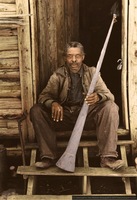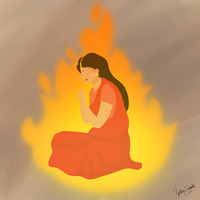Memory and Power
Though many of the archive contributions in earlier course units drew on themes related to power and the creation of memory, in this week we explicitly focused on theories that explain the relationship between memory and power. Some of the earlier Durkheimian inspired theories described memory as a tool that generates social solidarity. In contrast, in this week we met theorists that explained how memory can be subject to social control and manipulation, to the advantage of some and disadvantage of others. The first two readings we talked about were written by Marxist scholars. The first essay, by the Popular Memory Group, contrasted "dominant memory" with "popular memory." The second essay was written by influential Marxist historian Eric Hobsbawn. He introduced us to the concept of "invented traditions." Finally, sociologist Orlando Patterson, using the concept of "natal alienation," helped us to think about the relationship between slavery, society, and collective memory.
Domination through Censorship
Ground Zero is a novel about the dualing perspectives of an Afghan girl and an American boy in the aftermath of 9/11. It is also one of the novels that Texas parents want removed from school libraries. Their reasoning is that it depicts American soldiers in a negative light and mentions race. There are over 50 novels facing this same potential erasure.
Novels such as these, even if they are based in fiction, are historical representations and contribute to our collective memory of events. When groups try to censor these mediums, they are intervening with memory and attempting to reshape our historical accounts. The Popular Memory Group describes memory as a business in which we market historical representations of many forms; some of which are more likely to gain access to the public field. Memory narratives are competing for this access and the dominant narratives, while they can prevail, are often contested. Novels like these contest the dominant memories by giving alternative perspectives to historical events that the state controls. In this competition for representation, the Popular Memory Group explains that "certain representations achieve centrality and luxuriate grandly; others are marginalized or excluded or reworked" (Olick et al., 2011). Censorship efforts such as these attempt to further marginalize through the exclusion of memory narratives. Contributed by J.V.
In this week’s reading, Orlando Patterson explains how “denying the slave’s humanity” (Olick et al, 2011: 281) resulted in the loss of an entire culture through the concept of natal alienation. The image I have chosen above is a photograph of Willis Winn colourized by Tom Marshall. I believe that colourizing this picture humanizes this individual and allows us to see past the circumstances that were forced upon him. The colour also displays the image in a more emotional and communicative way which helps people see this individual in a different perspective.
Patterson states that “slaves had no custodial claims or powers over their children, and children inherited no claims or obligations to their parents” (Olick et al, 2011: 280) and this loss of power is reflected in Willis’ last name, which was given to him by the individual that enslaved him, whose name was Bob Winn (Federal Writers' Project: Slave Narrative Project, 1936: 201). His real name would not be documented or passed down to his children and they would go on to take on the surname ‘Winn’ as well. This emphasizes the “loss of ties” (281) and the loss of culture that they’ve experienced, and their families will continue to experience as well. However, there were many enslaved individuals that decided to take their power back by changing their last name after emancipation.
Many enslaved individuals were forced apart from their families, which made it impossible for them to form stable and secure family lives. Throughout the years, this cultural disconnection has had tremendous generational effects. Many individuals in today’s world do not feel connected to their past because their past was taken from them. (Contributed by GS)
My Body, My Choice: Power and Media Constructions Alter Memory?
This is a picture of a woman holding the sign "My Body, My Choice" which was created as a slogan for Women's Rights activism and the continued battle with political authorities and the ban on abortions. However, today I pose this question: when you hear "My Body, My Choice" does your memory bring forth the battle women have fought for decades regarding their autonomy or does it bring up the Vaccine mandate fights, and the anti-masking protests? According to the essay by The Popular Memory Group, “The media certainly produce their own historical account- They produce a contemporary history daily, for instance, in the form of “news” (p.256) that the media can then “transform constructions of the past produced elsewhere” (p.256). The Memory of the meaning of a slogan or protest we see today can be shifted through media and political support to change the collective memory. In other words, media and politics have the power to shape the way we remember events, ideas, and even the meaning of slogans. Furthermore, the past generations hear the phrase “My Body, My Choice" and think back to two different kinds of memory however still placing more value on the original use and meaning because that generation was present for those protests and fights. However, the next generation may have more memory of the COVID-19 protests, the vaccine mandate and anti-masking protests, and the freedom convoy because they were present for that, and the media highlighted it more in the news than they ever did with Women's Rights.
Sati Tradition - Widow Burning
Trigger Warning: Abuse Against Women, Homicide.
This week's reading includes Eric Hobsbawm's piece on "inventing Traditions," which explains that many traditions are "deliberately invented and constructed" and practised for "convenience and efficiency.". Many past ( and in some odd cases in the present ) traditions practised in India for "religious reasons (particularly Hinduism. I cannot speak for other religions), were invented by the upper cast, primarily men, to dominate the lower cast or women. One of which is called Sati or widow burning. And it's literally the burning of widowed women or young girls (child marriages were also a tradition/norm) along with their dead husbands on the pyre.
Not only is this tradition obscure, but as mentioned by Hobsbawm that "[t]he actual process of creating [the said ritual] has not been adequately studied by historians." When I was first told about this tradition by my mom, she explained that women were told to sacrifice themselves on the pyre so that God could keep them together in the afterlife or the next life??? These women were young and uneducated. Most of what was taught to them was religion-based.
There is a lot of debate and ideas about how this tradition started. Some sources say it started because an entire community of women didn't want to be slaves of colonizers after their husbands were killed in battle.
Sati tradition was banned in 1829, and the last know case was the unsolved case of Roop Kumar in 1987. (contributed by I.S.)



